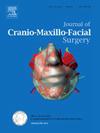经腭与前入路在手术辅助MARPE下治疗翼颌分离:CBCT评估。
IF 2.1
2区 医学
Q2 DENTISTRY, ORAL SURGERY & MEDICINE
引用次数: 0
摘要
本研究旨在评估在上颌扩张手术中采用微创手术辅助快速腭扩张(SARPE)合并前路翼颌分离,或采用前路和经腭翼颌截骨术(TPMO)对骨骼、牙槽骨和颅颌面缝合线以及上呼吸道变化的影响。每位患者均获得术前和术后锥形束计算机断层扫描(CBCT)图像。50例患者:对照组(微创扭转技术)25例,试验组(微创扭转技术联合TPMO) 25例。两组患者上颌扩张均有统计学意义,试验组上颌前牙增加幅度更大(5.60 mm vs 4.10 mm)。两组患者的鼻腔宽度、上气道面积和翼颌分离均有所增加。两组均出现颊牙倾斜和腭骨厚度增加。额鼻缝线和颧骨宽度保持稳定。研究结果表明翼颌分离保证了后腭扩张,而其他颅颌面缝合不受影响。然而,经腭翼颌截骨术可以更精确地切开翼状骨缝合线,促进上颌骨的下骨折,最终降低相关的发病率。本文章由计算机程序翻译,如有差异,请以英文原文为准。
Transpalatal vs anterior approach for pterygomaxillary disjunction in the context of surgically assisted MARPE: CBCT assessment
This study aimed to evaluate the effects on skeletal, dentoalveolar, and craniomaxillofacial sutures, and on upper airway changes, of performing minimally invasive surgically assisted rapid palatal expansion (SARPE) with pterygomaxillary disjunction through an anterior approach, or using a combination of anterior and transpalatal pterygomaxillary osteotomy (TPMO) in maxillary expansion procedures. Pre- and postoperative cone-beam computed tomography (CBCT) images were obtained for each patient. Fifty patients were included: 25 in the control group (minimally invasive twist technique) and 25 in the test group (minimally invasive twist technique combined with TPMO). Both groups showed statistically significant maxillary expansion, with the test group exhibiting a greater anterior maxillary increase (5.60 mm versus 4.10 mm). Both groups experienced an increase in nasal cavity width, upper airway area, and pterygomaxillary disjunction. Buccal tooth inclination and increased palatal bone thickness were present in both groups. The frontonasal suture and zygomatic bone width remained equally stable. The results of study indicate that pterygomaxillary disjunction guarantees posterior palatal expansion, whilst other craniomaxillofacial sutures are not affected. However, transpalatal pterygomaxillary osteotomy allows a more precise split of the pterygoid suture, facilitates down-fracture of the maxilla, and ultimately decreases associated morbidity.
求助全文
通过发布文献求助,成功后即可免费获取论文全文。
去求助
来源期刊
CiteScore
5.20
自引率
22.60%
发文量
117
审稿时长
70 days
期刊介绍:
The Journal of Cranio-Maxillofacial Surgery publishes articles covering all aspects of surgery of the head, face and jaw. Specific topics covered recently have included:
• Distraction osteogenesis
• Synthetic bone substitutes
• Fibroblast growth factors
• Fetal wound healing
• Skull base surgery
• Computer-assisted surgery
• Vascularized bone grafts

 求助内容:
求助内容: 应助结果提醒方式:
应助结果提醒方式:


